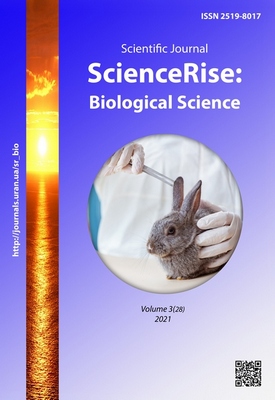Morphological and anatomical properties of Veronica crista-galli Steven
DOI:
https://doi.org/10.15587/2519-8025.2021.241865Keywords:
Veronica crista-galli Stev., leaf, flower, fruitAbstract
The aim of this work was to study of diagnostic signs of the morphological and anatomical structure of Veronica crista-galli Steven. from the flora of Azerbaijan.
Materials and methods. The samples for research were collected during their flowering time in June 2018, in the Ismailli region of the Republic of Azerbaijan. Plant samples were fixed in a solution made in 0.1 M phosphate buffer (pH=7.4), containing 2.5 % glutar-aldehyde, 2.5 % paraformal-aldehyde and 0.1 % picric acid. In the next stage was the preparation of block and their filling in Araldite – Epon according to the TEM method.
Results. The leaf is simple, lower part is short-petiolate and upper is sessile. The surface, on both sides of the leaf, is reliefly, and 7–8 conductive veins are clearly visible. The lower and upper sides of the leaf, and also margin, are strewn with multicellular hairs. The calyx of the flower consists of two sepals which grown together at the base, covered with simple multicellular hairs. The stalk in is a long filiform. The corolla of flower consists of 4 petals which grown together at the base and 2 stamens attached to the tube of the corolla. On the epidermis, cells with sinuous and bead-like walls, numerous stomata of the stavrocytic type, capitate hairs are visible. From the cross section of the leaf, it is visible that palisade tissue at the upper and sponge tissue at the bottom.
Conclusions. As a result of morphological and anatomical studies, it was revealed that diagnostic signs of plant raw material can be: Present of multicellular hairs on the leaf blade; The location of the capsule between the sepals; Stavrocytic type of the stoma structure; The bead-like walls of the epidermis; Capitate hairs on the epidermis; Sepals covered by hairs.
The established anatomical diagnostic features can be used for the drafting of the normative document on the plant raw materials and for identification of plant raw material of Veronica crista-galli
References
- Kerimov, Yu., Suleimanov, T. (2016). Na sobstvennoi syrevoi baze. Vestnik Natsionalnoi Akademii Nauk Azerbaidzhana, 19–22.
- Akanda, M. R., Nam, H.-H., Tian, W., Islam, A., Choo, B.-K., Park, B.-Y. (2018). Regulation of JAK2/STAT3 and NF-κB signal transduction pathways; Veronica polita alleviates dextran sulfate sodium-induced murine colitis. Biomedicine & Pharmacotherapy, 100, 296–303. doi: http://doi.org/10.1016/j.biopha.2018.01.168
- Dunkić, V., Kosalec, I., Kosir, I., Potocnik, T., Cerenak, A., Koncic, M. et. al. (2015). Antioxidant and antimicrobial properties of Veronica spicata L. (Plantaginaceae). Current Drug Targets, 16 (14), 1660–1670. doi: http://doi.org/10.2174/1389450116666150531161820
- Saracoglu, I., Oztunca, F. H., Nagatsu, A., Harput, U. S. (2011). Iridoid content and biological activities ofVeronica cuneifoliasubsp.cuneifoliaandV. cymbalaria. Pharmaceutical Biology, 49 (11), 1150–1157. doi: http://doi.org/10.3109/13880209.2011.575790
- Sun, Y., Lu, Q., He, L., Shu, Y., Zhang, S., Tan, S., Tang, L. (2017). Active Fragment ofVeronica ciliataFisch. Attenuates t-BHP-Induced Oxidative Stress Injury in HepG2 Cells through Antioxidant and Antiapoptosis Activities. Oxidative Medicine and Cellular Longevity, 2017, 1–11. doi: http://doi.org/10.1155/2017/4727151
- Yin, L., Lu, Q., Tan, S., Ding, L., Guo, Y., Chen, F., Tang, L. (2016). Bioactivity-guided isolation of antioxidant and anti-hepatocarcinoma constituents from Veronica ciliata. Chemistry Central Journal, 10 (1). doi: http://doi.org/10.1186/s13065-016-0172-1
- Kroflič, A., Germ, M., Golob, A., Stibilj, V. (2018). Does extensive agriculture influence the concentration of trace elements in the aquatic plant Veronica anagallis-aquatica ? Ecotoxicology and Environmental Safety, 150, 123–128. doi: http://doi.org/10.1016/j.ecoenv.2017.10.055
- Saracoglu, I., Harput, U. S. (2011). In Vitro Cytotoxic Activity and Structure Activity Relationships of Iridoid Glucosides Derived from Veronica species. Phytotherapy Research, 26 (1), 148–152. doi: http://doi.org/10.1002/ptr.3546
- Süleymanov, T. A., Paşayeva, N. H., Stev, V. P., Stev, V. C.-G. (2018). Xammalında spektrofotometrik üsulla flavonoidlərin miqdari təyini. Azərbaycan təbabətinin müasir nailiyyətləri, 8, 121–123.
- Saracoglu, I., Suleimanov, T., Pashaeva, N., Dogan, Z., Inoue, M., Nakashima, K. (2020). Iridoids from Veronica crista-galli from the Flora of Azerbaijan. Chemistry of Natural Compounds, 56 (4), 751–753. doi: http://doi.org/10.1007/s10600-020-03139-3
- Kuo, J. (2007). Electron microscopy: methods and protocols. Totowa: Humana Press, 625.
- Agayeva, N. J., Rzayev, F. H., Gasimov, E. K., Mamedov, C. A., Ahmadov, I. S., Sadigova, N. A. et. al. (2020). Exposure of rainbow trout (Oncorhynchus mykiss) to magnetite (Fe3O4) nanoparticles in simplified food chain: Study on ultrastructural characterization. Saudi Journal of Biological Sciences, 27 (12), 3258–3266. doi: http://doi.org/10.1016/j.sjbs.2020.09.032
- AL-Abide, N. M. (2019). A morphological and anatomical comparative Study of the Reproductive parts of the genusVeronicaL. (Plantaginaceae) in northern Iraq. Journal of Physics: Conference Series, 1294, 062114. doi: http://doi.org/10.1088/1742-6596/1294/6/062114
- Kaplan, A., Hasanoglu, A., Agah Ince, I. (2006). Morphological, Anatomical and Palynological Properties of Some Turkish Veronica L. Species (Scrphulariaceae). International Journal of Botany, 3 (1), 23–32. doi: http://doi.org/10.3923/ijb.2007.23.32
Downloads
Published
How to Cite
Issue
Section
License
Copyright (c) 2021 Nigar Hidayet Pashayeva, Tahir Abbasali Suleymanov, Yusif Balakerim Kerimov, Eldar Kocheri Gasimov, Fuad Huseynali Rzayev

This work is licensed under a Creative Commons Attribution 4.0 International License.
Our journal abides by the Creative Commons CC BY copyright rights and permissions for open access journals.
Authors, who are published in this journal, agree to the following conditions:
1. The authors reserve the right to authorship of the work and pass the first publication right of this work to the journal under the terms of a Creative Commons CC BY, which allows others to freely distribute the published research with the obligatory reference to the authors of the original work and the first publication of the work in this journal.
2. The authors have the right to conclude separate supplement agreements that relate to non-exclusive work distribution in the form in which it has been published by the journal (for example, to upload the work to the online storage of the journal or publish it as part of a monograph), provided that the reference to the first publication of the work in this journal is included.









